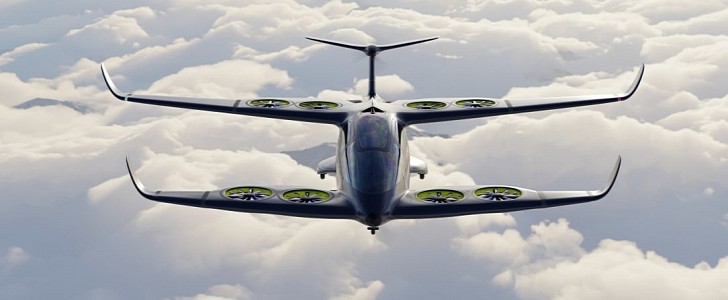It features eight rotors integrated into two fixed wings and two propellers, one at the top of the tail and another mounted on its nose. Thanks to this configuration, the vehicle will be able to take off and land both vertically and horizontally. The cabin has skyview windows that add to the unique design and offer a feeling of open space.
The aircraft boasts an impressive range of 249 miles (400 km). Once operational, Atea will be able to fly in the cities and around them, taking passengers on up to 2-hour trips. Its hybrid propulsion system uses kerosene and batteries to reduce fuel consumption. Not only that, but it also helps reduce carbon emissions by up to 80 percent.
The integration of vertical rotors in the wings with a disruptive duct design improves the aircraft's noise signature significantly. When compared to a helicopter, Atea generates up to four times less noise.
Since it will operate in an urban environment and in the vicinity of the cities, this will be a major advantage. The company will be able to integrate its VTOL in a wide range of missions such as passenger transportation, Emergency Medical Services, sightseeing, and Surveillance and Patrol.
Ascendance says that this is just the beginning as it plans to make the aircraft's engine compatible with Sustainable Aviation Fuel (SAF) and ultimately eliminate all emissions. The hybrid propulsion system's combination of two energy sources also improves reliability and operational range. Atea was designed in accordance with EASA SC-VTOL standards, and it complies with the Air Operation Regulation.
Currently, the aircraft is under development. So far, we've only seen renderings of its design. However, "ATEA will soon exist in the form of a full scale prototype and will go into testing phase in 2023," explains Jean-Christophe Lambert, Ascendance CEO. "With help from our financial partners we are now experiencing vigorous development. We are actively recruiting, running test and trial programs and we are steadily moving towards our 2025 certification objective."
Until that takes place, Ascendance plans to present its new VTOL at the 2024 Summer Olympics in Paris.
?? ???????????????? ???????????? ???????????????????????? ???????? ???????????? ???????????????????????????????? ??
— Ascendance Flight Technologies (@ascendance_ft) December 1, 2021
We're thrilled to introduce ATEA,
Our hybrid electric #VTOL aircraft!
A more #sustainable regional #airmobility solution:
???? 80% carbon emissions reduction
???? 4 times less noise pollution
???? 400km autonomy pic.twitter.com/fWsg7LWrpp





